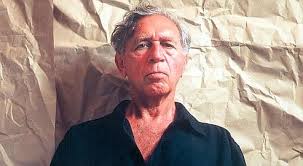 In Art for an Undivided Earth: The American Indian Movement Generation, Jessica L. Horton explores how the artists of the American Indian Movement (AIM) generation remapped the spatial, temporal, and material coordinates of modernity by placing colonialism’s displacement of indigenous people, objects, and worldviews at the center of their work. Inspired to see the work Horton discusses in person? Read on to learn more about the artists and where their art is on display.
In Art for an Undivided Earth: The American Indian Movement Generation, Jessica L. Horton explores how the artists of the American Indian Movement (AIM) generation remapped the spatial, temporal, and material coordinates of modernity by placing colonialism’s displacement of indigenous people, objects, and worldviews at the center of their work. Inspired to see the work Horton discusses in person? Read on to learn more about the artists and where their art is on display.
Jimmie Durham
Jimmie Durham (born 1940 in Washington, Arkansas) is an activist, sculptor, essayist, and poet whose works are held in major collections around the globe. In Art for an Undivided Earth, Jessica Horton explains: “Throughout the 1980s and early 1990s, Durham exhibited alongside, collaborated with, and wrote about the work of fellow indigenous artists. He profoundly impacted a discourse about Native American art and settler colonialism long after he moved to Mexico in 1987 and to Europe in 1994, at which time he cut his ties to U.S. institutions.” A highly-anticipated retrospective of Durham’s work  began at the Hammer Museum, Los Angeles in January 2017; it is now on display at the Walker Art Center in Minneapolis, and later heads to The Whitney Museum of American Art in New York, and the Remai Modern in Saskatoon.
began at the Hammer Museum, Los Angeles in January 2017; it is now on display at the Walker Art Center in Minneapolis, and later heads to The Whitney Museum of American Art in New York, and the Remai Modern in Saskatoon.
James Luna

James Luna (born 1950 in Orange, California) is a Payómkawichum and Mexican-American artist known for his photography, performance art, and multimedia installations. According to Horton, “Luna’s work culminated a decade of curatorial efforts in the United States and Canada to enhance the visibility of Native artists at the Venice Biennale, the oldest and some say most prestigious art exhibition in the world.” Luna’s corpus of work is displayed on his website; the site also provides videos of his performance art. You can view Luna’s work, including his famous piece “Half Indian/Half Mexican,” in person by visiting the Denver Art Museum’s American Indian Collection.
Fred Kabotie

Fred Kabotie (1900-1986) was a Hopi artist best known for his painting, silverwork, illustrations, and pottery. In Art for an Undivided Earth, Horton points out that Kabotie “painted social and ceremonial dances from memory as government-imposed education and widespread bans on ritual practices aimed to transform Native bodies into productive labor for the U.S. economy in the first decades of the twentieth century.” Within Kabotie’s early works, Horton notes, this reveals “a persistent concern with maintaining Hopi sensibilities amid displacement.” Fred Kabotie’s work can be found in the Great Plains Art Museum’s Patricia J. and Stanley H. Broder Collection, the Albuquerque Museum’s permanent collection, and a current exhibit, “Spirit of Creation,” also at the Albuquerque Museum.
Kay Walkingstick

Kay WalkingStick (born 1935 in Syracuse, NY) is a landscape artist whose later paintings often incorporate patterns from Native American pottery and rugs. These landscapes are particularly remarkable because, as Horton emphasizes, “Walkingstick’s artistic practice refuses a logic of difference that lingered in late twentieth-century debates about modernist primitivism, the Indian Arts and Crafts Act of 1990, and the Columbus Quincentennial, by forging affective bonds with white artistic predecessors.” Her work is in the collections of museums around the globe, including the Metropolitan Museum of Art, in New York and the National Museum of the American Indian in Washington, DC. A retrospective of Walkingstick’s work, “Kay Walkingstick: An American Artist,” will travel to the Kalamazoo Institute of Arts, Kalamazoo MI, the Gilcrease Art Museum, Tulsa OK, and the Montclair Art Museum, Montclair NJ, during 2017 and 2018. If you can’t make it to one of these museums, Walkingstick’s work is also displayed digitally on her website.
Robert Houle

Robert Houle is a Saulteaux First Nations Canadian artist, critic, and curator who has worked to unify First Nations contemporary artists with the larger Canadian art scene. In Art for an Undivided Earth, Horton explains that Houle’s mixed-media works “revisit the entwined lineages of ethnography and abstraction to tell a survival story” (14). Houle’s work can be found in many public collections, including the Art Gallery of Ontario, Toronto ON, the Heard Museum, Phoenix AZ, the Art Gallery of Sudbury, Sudbury ON, and the National Gallery of Canada, Ottawa ON.
To save 30% on Art for an Undivided Earth use coupon code E17HORTN at checkout on our website.
